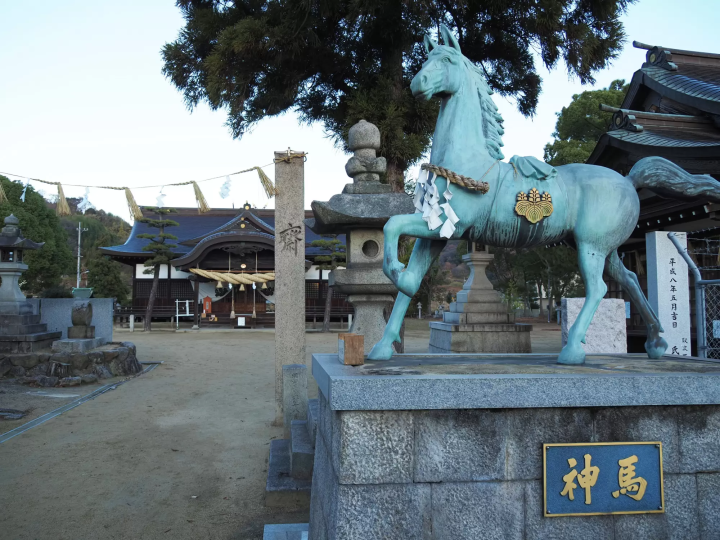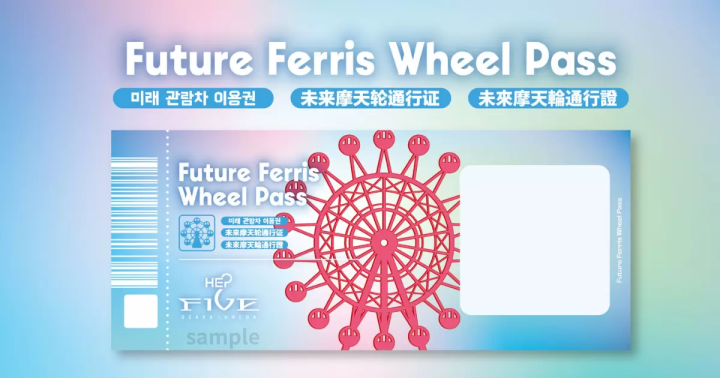NINJA WiFi: Review, How to Use, 35% Discount Coupon

NINJA WiFi is one of Japan’s top portable routers with high-speed internet, an intuitive interface, and English support. Enjoy a 35% discount! Find a review and tips on how to rent and use it.
NINJA WiFi: Highly Rated Pocket WiFi in Japan
We've tested Ninja WiFi. Check our review in this video.
Due to the limited availability of free, reliable Wi-Fi in Japan, it is essential to use a pocket Wi-Fi router during your trip. A pocket Wi-Fi is a portable device that provides internet access and is more affordable than roaming charges, offering a large amount of data for your use.
In this article, we highlight the features of NINJA WiFi, a popular Japanese pocket Wi-Fi provider. You'll find reviews, instructions on how to rent it, where to pick it up, and an exclusive coupon for MATCHA readers that provides up to a 35% discount on usage fees.
Additionally, we offer recommendations for other Wi-Fi services besides NINJA WiFi, as well as a comparison with SIM cards, which you can find in the Frequently Asked Questions section at the end.
NINJA WiFi: Review and Usage Guide
1. NINJA WiFi: Features and Benefits
- Data at a Reasonable, Fixed Flat Rate
- High Speed and Plenty of Data Capacity
- Convenient Pick-Up: Airport Counters and Other Locations
2. No.1 Reason to Choose NINJA WiFi: High Usability
3. Review: Pros and Cons of Using NINJA WiFi
4. How to Rent and Use the NINJA WiFi
5. Frequently Asked Questions
NINJA WiFi: Features and Benefits
Although various companies in Japan offer rental WiFi services, our top recommendation is NINJA WiFi, known for its unlimited data at a fixed flat rate.
This pocket WiFi is especially popular among international visitors due to its reliability and convenience. Below, we highlight the main features of NINJA WiFi.
1. Data at a Reasonable, Fixed Flat Rate
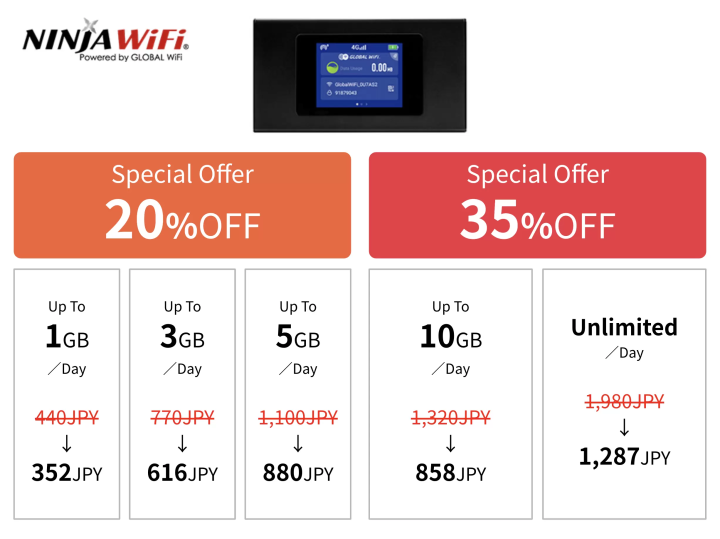
NINJA WiFi offers some of the most affordable WiFi services in Japan, whether you choose a low-capacity or a high-capacity data plan.
As of January 2025, NINJA WiFi has five main plans available. For MATCHA readers, the plans for 1GB, 3GB, and 5GB per day are offered at a 20% discount, while the 10GB and unlimited plans are available at a 35% discount.
During your stay in Japan, many travelers use social media and Google Maps regularly, and gaming can consume approximately 2–3 GB of data per person per day.
With NINJA WiFi's 10GB plan, you can comfortably connect multiple devices—up to five at once—and enjoy gaming and other activities without worry.
Users only pay for the days when they use the device.
For example, if you rent it for five days, it would be 770 yen x 5 days = 3,850 yen (including tax), which is a great deal.
Additionally, there is currently a 35% discount available for MATCHA readers. By using this discount, you can use it for 616 yen per day (3,080 yen for 5 days).
To get the 35% discount, book the NINJA WiFi from this page. No coupon code or promo code needed.
There are no additional charges for data communication fees, initial rental fees, or deposits when using a credit card. You can use the Internet without worrying about extra costs.
2. High Speed and Plenty of Data Capacity
The second amazing feature of NINJA WiFi is that the data capacity that you can use is very generous.
Sometimes, you end up using more data than expected looking up information on places to visit, transportation, and local souvenirs. Using NINJA WiFi is convenient because the data capacity is almost unlimited.
Additionally, if you've exceeded your data usage limit, the speed of your connection will be limited to 128 kbps, but you'll still be able to use the internet with no limits.
The company uses the Softbank 4G LTE, a network that allows a smooth connection. You can also enjoy videos without any stress.
Good to Know: Estimated Data Usage in Japan (1 GB)
Estimated Data Usage in Japan (1 GB)
E-Mail: 2,090 emails. (500 KB per mail)
Video Viewing: about 4 hours and 16 minutes at medium quality.
Google Maps: about 1,432 views (10 minutes per view).
Reference: Wi-Fi Rental Dotcom (Japanese)
3. Convenient Pick-Up: Airport Counters and Other Locations
Compared to other portable WiFi providers, NINJA WiFi offers numerous pick-up locations, making it easy to retrieve your device.
Airport Counters
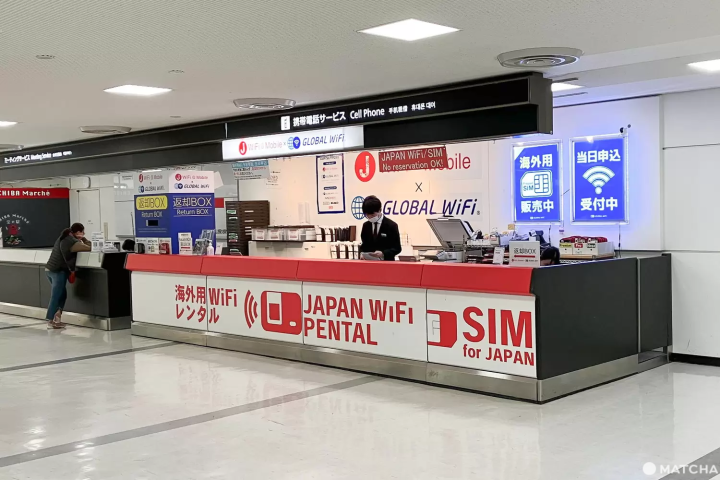
Pick-up counter at Narita Airport Terminal 2
Pick-up counters are available at 11 airports across Japan, including Terminals 1, 2, and 3 at Narita International Airport (Tokyo), Terminals 1 and 2 at Kansai International Airport (Osaka), Haneda Airport (Tokyo), Naha Airport (Okinawa), and New Chitose Airport (Hokkaido).
You can also book the Ninja WiFi with Welcome Suica (prepaid IC card for Japan public transportation) option, pick up them together at the airport counters, and take the train to start your journey right away. This means you won't need to wait in line to buy the Suica card.
MATCHA's Office in Tokyo: Near Asakusabashi Station (JR, Toei Subway)

MATCHA's office within LIT Higashi-Nihonbashi in Tokyo
You can also pick up your NINJA WiFi at MATCHA's office in Higashi-Nihonbashi, Tokyo (Map). Our office is located just 5 minutes on foot from Asakusabashi Station or Higashi-Nihombashi Station on the Toei Asakusa Line.
The best part about picking up your Ninja WiFi at MATCHA is that you can also receive free travel tips from our team members!
MATCHA's Office
Location: Map
Hours: Monday - Friday 10:00 - 18:00 *Closed on weekends.
NINJA WiFi Shinjuku Counter in Tokyo

The NINJA WiFi Shinjuku Counter
Pick-ups and returns are also possible at the Shinjuku Counter in Tokyo. Apply online by 15:00 and you can have same-day pick-up at the Shinjuku Counter. This is a great option for those who forgot to reserve a portable WiFi device before getting into Japan or suddenly require WiFi on the run.
There's also a convenient delivery service if you're planning to go sightseeing after arriving at the airport! You can either have your device delivered to you or even to a friend's house in Japan.
Please check the pick-up page on NINJA WiFi’s official website for details on airport pick-up counters and business hours. Pick-ups at the airport and Shinjuku Counter are free, but the delivery service costs 550 yen (tax included).
The Shinjuku Counter is a 12-minute walk from JR Shinjuku Station or just a one-minute walk from Tokyo Metro Higashi-Shinjuku Station. The office is located on the building’s fifth floor.
NINJA WiFi Shinjuku Counter
Location: Tokyo, Shinjuku, Kabukicho 2-4-10 Kdx Higashi Shinjuku 5F (Google Map)
Hours: Monday - Friday 10:00 - 18:00 *Closed on Saturdays and Sundays
Phone number: 0120-410-752
Website: https://ninjawifi.com/en
No.1 Reason to Choose NINJA WiFi: High Usability
In addition to being very affordable, NINJA WiFi is also easy to use—offering simple pick-up in Japan, instant setup, and reliable connectivity. Its high usability is supported by the following factors.
1. Highest Number of Airport Pick-up Counters
The number of airport counters where you can pick up your NINJA WiFi is the industry’s highest. Besides major airports, you can also find NINJA WiFi counters at regional airports like Kagoshima or Komatsu (Ishikawa).
Complete airport counter list: https://ninjawifi.com/en/receive/airport
2. Next Day Pick-up Available
For major airports (Narita, Haneda, Kansai), if you complete your reservation by 4:00 PM Japan time the day before, you can pick up the device the next day.
Check the airports with next-day pick-up here: https://ninjawifi.com/en/receive/airport
3. Multiple Pick-up Options
Besides airport counters, you can also pick up your NINJA WiFi at customer service counters in Tokyo, as well as from lockers and by home delivery. *Locker pickup is an industry first.
Check the complete pick-up location list here: https://ninjawifi.com/en/receive/smartpickup
4. Comprehensive English Customer Support
NINJA WiFi's English customer support is available 365 days a year, providing peace of mind even during your stay in Japan.
5. Receive Monthly Tips and Deals by Email
Once you're registered as a NINJA WiFi user, you'll receive monthly updates on money-saving tips and deals in Japan.
Review: Pros and Cons of Using NINJA WiFi
The author of this article rented and personally tested the NINJA WiFi. Below, he shares the advantages and disadvantages he experienced.
User-Friendliness: 100 Points
Lightweight Device + Instructions in English

The photo above shows all the rental items. Inside the case, you'll find the router along with accessories such as a charger, a return bag, and a receipt slip.

Inside the case, there is also an English instruction manual included.
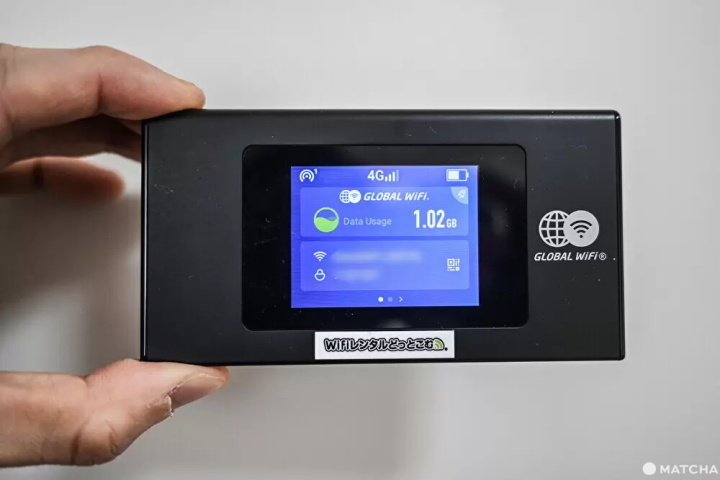
This is the router. It displays the data usage and remaining battery level clearly. The device quickly enters power-saving mode when the screen is not in use, which helps extend the battery life.
The router is thin and lightweight—so much so that I could hold it comfortably with the same feeling as holding an extra smartphone.
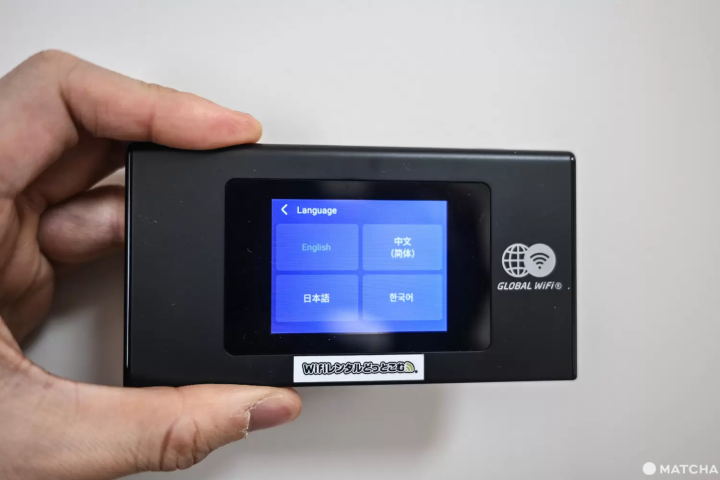
The screen includes a language selection option, allowing you to choose from English, Chinese, or Korean.
Connection Speed and Ease of Use: 100 Points

During my stay in Tokyo, I worked from cafes in Shinjuku, Harajuku, Sumida Ward, and other areas. I experienced no connectivity issues at any of these locations—all connections were very smooth.
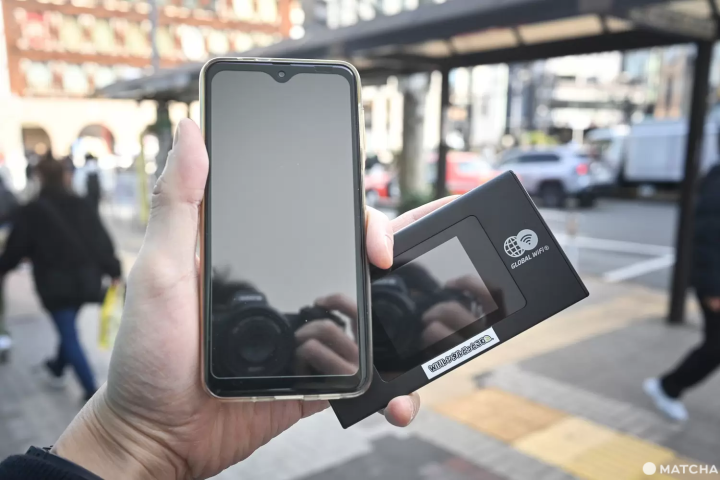
Using it on the streets of Tokyo, the internet connection remained smooth and hassle-free.
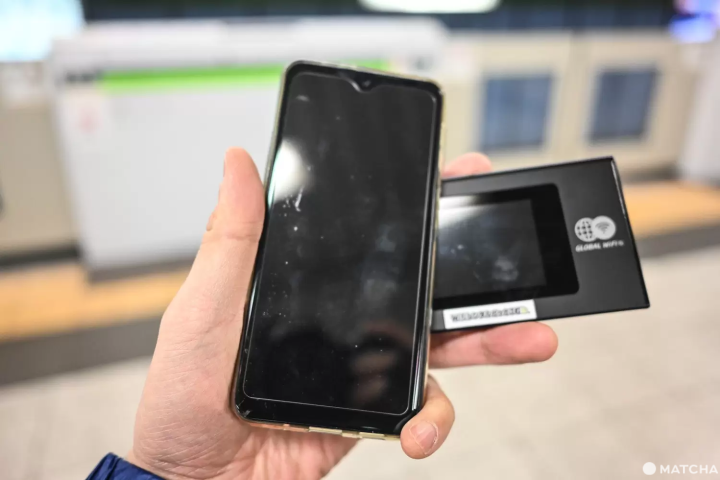
While using it on the subway, the connection was smooth within station premises. However, there were occasional brief interruptions while on the train, likely due to the weaker signal reception in the subway tunnels, so some caution may be required.

We also tested NINJA WiFi outside Tokyo.
The author lives in a rural town in Kagawa. While driving along mountain roads, they watched YouTube videos, and there were no significant slowdowns in connection speed.
Battery Life: 90 Points
During my stay in Tokyo, I kept my smartphone connected to WiFi from around 9:00 AM to 8:00 PM. During this time, I used approximately 1.5 GB of data, and the battery level was about 30% remaining.
This information is based solely on the author's personal experience, so battery life may vary depending on usage. Generally speaking, for a single user starting with a full charge in the morning when leaving the hotel, the battery should last until the evening without needing a recharge.
However, if the device is used by multiple people or for activities like gaming or watching videos that consume a lot of data, it’s advisable to carry a charger with you for peace of mind.
Comfort During Traveling: 60 Points
The Bulky Case May Be Hard to Carry Around
One drawback of using a WiFi router compared to a SIM card is the bulkiness of carrying the case and device while on the move.
Although the NINJA WiFi router itself is lightweight, the dedicated case is relatively large, making it somewhat cumbersome to carry in a backpack.
To address this, I stored the case in a suitcase and deposited it in a coin locker, carrying only the router in the backpack.
Even with the router in the backpack, it maintained a stable connection within approximately 50 centimeters. This allowed me to enjoy strolling through the city with the router in my backpack and my phone in hand, without any issues.
Review Summary
We have used several types of WiFi routers before, but as the latest model, Ninja WiFi offered an exceptional user experience!
How to Get NINJA WiFi: Rental Options, Pick-Up, and Returns
The process of renting, pick-up, and returns for NINJA WiFi is simple and friendly for international users.
How to Rent the NINJA WiFi
Reservations must be made online by 15:00 JST on the day before your intended pick-up at Narita Airport, Haneda Airport, and Naha Airport.
For Nagoya's Chubu International Airport (Centrair), reservations should be made two days in advance, and for New Chitose Airport (Hokkaido), three days in advance.
For detailed information on reservation deadlines, please visit the booking page on NINJA WiFi’s official website or click on the blue button below.
*MATCHA's readers receive a MAX 35% discount on NINJA WiFi rentals booked through this link.

Picture courtesy of NINJA WiFi
Enter the number of days you’ll be renting the device. In the example above, we chose five days from March 1 to March 5. Next, let's choose a plan.

Picture courtesy of NINJA WiFi
In our example, we chose a 3 GB Plan. Next, select the place of pick-up and return from the pull-down menu.
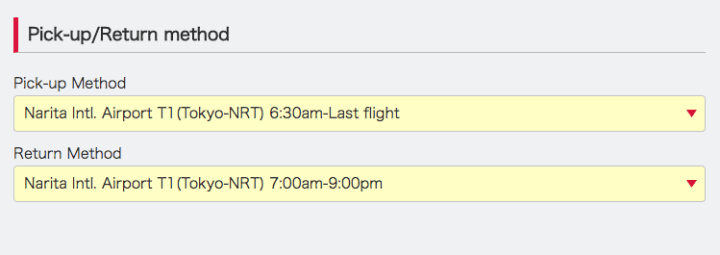
Picture courtesy of NINJA WiFi
For pick-ups and returns at Narita Airport Terminal 1, be sure to select the same option as the photo above. If you want your device to be delivered, then select “Delivery Services.”
If you choose to pick up the router at the Shinjuku location, then select “Shinjuku office 10:00-18:00 on weekdays.”

Picture courtesy of NINJA WiFi
Lastly, enter your personal information to complete your reservation!
How to Pick Up Your NINJA WiFi
Pick up your device at the location you selected when making your reservation. English-speaking staff will be available at airport pick-up counters and the Shinjuku Counter. Those not confident in their Japanese skills will have no problems!
If you choose to return the device by delivery, you will receive a return envelope at the time of your pick-up. Be sure not to lose this envelope while traveling.
How to Return Your Pocket WiFi
You will return your device using the method you specified on your reservation.
Those who selected the airport should return their device at the NINJA WiFi counter before boarding their flight. You won’t be able to return the router once you go past baggage security. Once you arrive at the airport, it's recommended to head to the counter right away.

Photo by Pixta
If you chose the delivery method, use the Yamato Transport waybill provided in your rental kit. Please complete the delivery process at a convenience store or a Yamato Transport counter inside the airport. The items required will already be filled out for you on the waybill.
If you choose to return the device at the Shinjuku Counter, go there on your return date. Do note that the business hours are 10:00 – 18:00 on weekdays only. Those who plan to return their devices on the weekend should select delivery or the airport counter instead.
Additionally, when returning the device by mail in Japan, it is necessary to write a Japanese address on the return slip. This can include the address of your hotel or wherever you are staying during your visit.
Frequently Asked Questions
So far, we have mainly introduced the benefits of Ninja WiFi.
On the other hand, there are other services in Japan with different features from Ninja WiFi. Here, we will focus on introducing such points.
Q1. Are there any recommended pocket Wi-Fi services other than Ninja WiFi?

Photo by Pixta
In Japan, there are many pocket WiFi services, including Ninja WiFi. In particular, the following two services are worth comparing:
Japan Wi-Fi Rental
While Ninja Wi-Fi boasts the lowest prices in Japan, Japan Wi-Fi Rental is cheaper when renting for two weeks or longer.
Japan Wireless
Japan Wireless offers a unique plan where there are speed restrictions but unlimited data usage. It is suitable for those who want to use the internet without data limitations.
Furthermore, while Ninja Wi-Fi is primarily a service for short-term travelers staying in Japan for about one week to one month, there are also other recommended services for long-term stays (one month or longer).
Please check the following MATCHA article for more information on these services.
Q2. Does Ninja WiFi support 5G?

Photo by Pixta
In short, Ninja Wi-Fi does not support 5G.
5G internet services are gradually being introduced in Japan. However, many pocket Wi-Fi services for foreign visitors to Japan have not yet adopted 5G.
Based on our personal experience, we haven't felt significant drawbacks using 4G for activities like watching videos or online meetings. However, for those who specifically require fast speeds, there are services that offer 5G capabilities.
CD JAPAN
CD JAPAN offers pocket WiFi with 5G using the WiMAX network (*). This service is primarily for long-term stayers, but you can rent it starting from 10 days for 6,050 yen.
*WiMAX uses a communication method using microwaves. It offers advantages such as unlimited data usage compared to the LTE networks of DoCoMo, au, and Softbank, but it is said to have less stable connectivity.
Global Advanced Communications
Global Advanced Communications also provides pocket WiFi with 5G capabilities. The 5G plan costs approximately 75.49 dollars (11,000 yen) for one week. However, the specific network being used is not mentioned on their official website.
Q3. How reliable is Softbank's network?

Photo by Pixta
Softbank, the provider of the network for Ninja WiFi, entered the broadband business in 2001 and is considered one of the three major telecommunications companies in Japan alongside DoCoMo (NTT) and au (KDDI) (although the inclusion of Rakuten makes it four major companies now).
DoCoMo originated from NTT, a formerly state-owned company, and has been involved in mobile communication services since the 1960s. As for au, they have been providing mobile phone services since the 1980s. In contrast, Softbank is a relatively newer corporation.
Due to these historical differences, DoCoMo and au have a greater number of base stations that connect radio waves compared to Softbank. Especially in remote islands and mountainous areas, DoCoMo tends to have better connectivity.
At most travel destinations in Japan, there is honestly not much difference in network choice. However, if your main focus is visiting remote islands or rural areas, choosing a service that uses DoCoMo or au's network might be the best option.
Sakura Mobile provides services using DoCoMo's network. Additionally, although it caters more towards long-term stays, Mobal offers a unique pocket WiFi that connects to all three networks: DoCoMo, au, and Softbank.
Q4. Which is better, SIM cards or pocket WiFi?
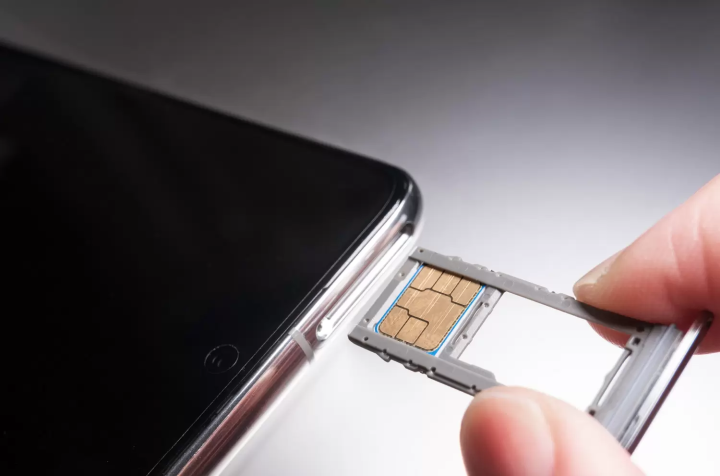
SIM cards require the hassle of switching. Photo by Pixta
When using the internet in Japan, along with pocket WiFi, inserting a SIM card directly into your smartphone is also popular.
SIM cards have several advantages over pocket WiFi.
Firstly, since SIM cards are directly inserted into smartphones, there is no need to carry a separate device like a WiFi router. Therefore, it is more convenient, and there is no risk of damaging or losing the device (if a WiFi router is damaged or lost, additional fees apply).
Furthermore, in recent years, eSIM services have been introduced, allowing you to use the SIM card immediately through online procedures. With a WiFi router, you need to receive it at an airport or hotel, but with an eSIM, that is not necessary.
However, SIM cards can be cumbersome to replace by opening the slot on your smartphone. Additionally, some services using eSIM may restrict tethering with other devices like computers or smartphones.
On the other hand, pocket WiFi is easy to set up and can easily connect to multiple computers and smartphones, making it more convenient.
Each has its own pros and cons, so please consider which one suits you better when making a choice.
Read also
Q5. How reliable is the free Wi-Fi in Japan?
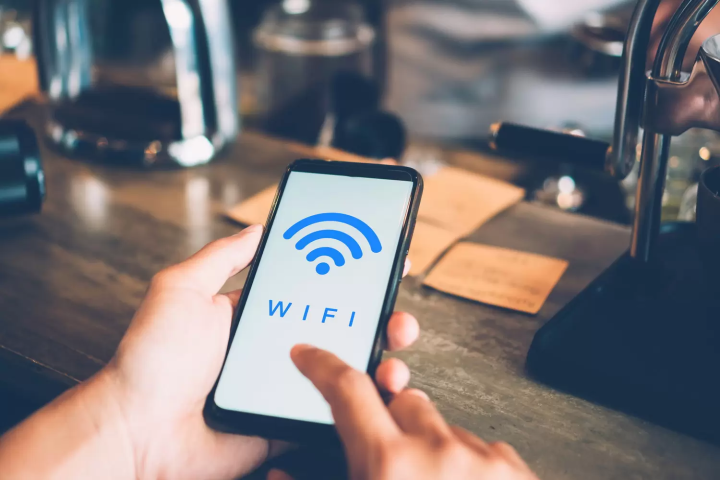
Photo by Pixta
In recent years, the number of spots providing free WiFi has been increasing in Japan, including not only train stations and airports but also cafes in the city.
However, in most places other than such establishments, free WiFi is not readily available. To prepare for visiting outdoor tourist destinations or using Google Maps in the city, it is recommended to have either a pocket WiFi or a SIM card.
For more information on where free WiFi is available, please check the following MATCHA article.
Main image by Pixta





























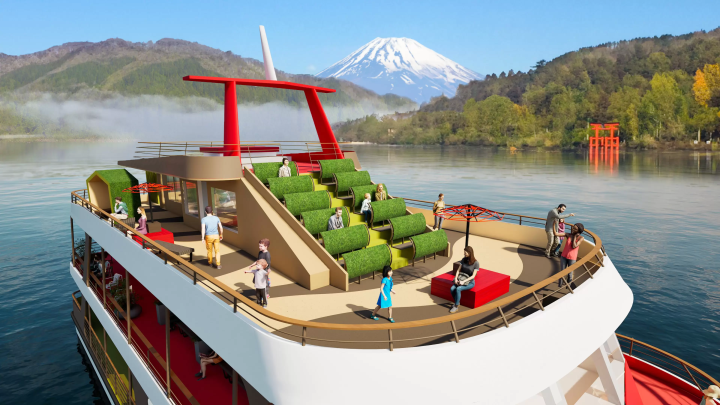

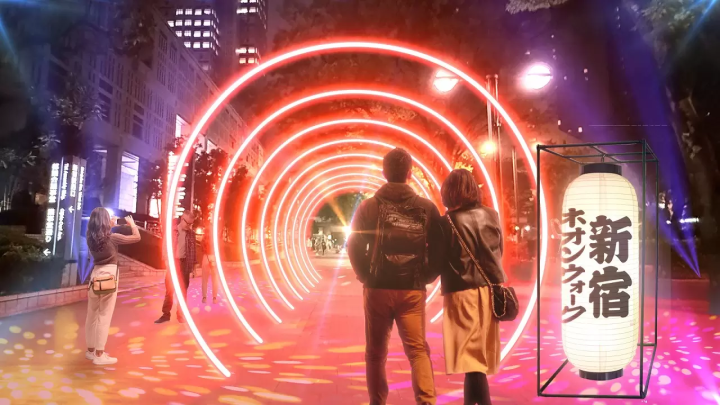





![[2026] Top 5 Strawberry Picking Spots in Tokushima, Naruto| Farms and Access Guide for January to May](https://resources.matcha-jp.com/resize/720x2000/2025/03/06-227165.webp)


